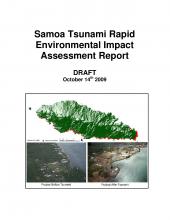2009 Global Assessment Report on Disaster Risk Reduction: Risk and poverty in a changing climate: invest today for a safer tomorrow

Climate Change Resilience
Available Online
Development efforts are increasingly at risk. A faltering global economy, food and energy insecurity, conflict, global climate change, declining ecosystems, extreme poverty, and the threat of epidemics seriously challenge progress towards improving social welfare and economic growth in many developing countries. In 2008, the deaths of approximately 140,000 people in the Myanmar cyclone and the collapse of more than five million buildings and damage to 21 million more in the China earthquake, were stark reminders that disaster risks associated with tropical cyclones, floods, earthquakes, droughts and other natural hazards are a key part of this interlocked set of threats. The Global Assessment Report on Disaster Risk Reduction focuses attention on that challenge. It identifies disaster risk, analyses its causes, shows that these causes can be addressed and recommends the means to do so. The over-riding message of the Report is that reducing disaster risk can also help in reducing poverty, safeguarding development and adapting to climate change, with beneficial effects on broader global security, stability and sustainability. Given the urgency posed by climate change, the Report forcefully argues the case for taking action now.



